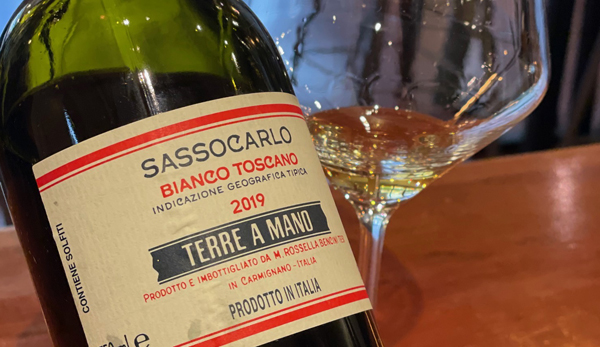2019 Fattoria di Bacchereto – Rosella Bencini Tesi, Terre A Mano Sassocarlo, Bianco Toscano IGT, Carmignano, Tuscany, Italy.
The deeply golden hued Terre A Mano Sassocarlo Bianco Toscano IGT, made from 80% Trebbiano (Tuscano) 80% and 20% Malvasia, saw some skin contact and a natural fermentation, with natural yeasts in cement vats, with malolactic fermentation and aging done in 350L (hogheads?) Allier oak barrels, with the wine maturing typically on the lees for between 12-18 months. There’s some savory grip, a slight oxidative nuttiness and a bone dry medium bodied palate that id vibrant and slightly earthy with persevered lemon, white peach, baked pear and quince fruits leading the way, with sea shore notes, wet stones, cedar, herbal tea and pecan notes. This is interesting stuff from the certified all organic and biodyamically farmed Fattoria di Bacchereto, located in the tiny and remote Carmignano region in Tuscany, a mostly unknown small estate, which produces mainly a rustic red wine that has an earthy and powerful appeal and made from classic Sangiovese (75%), Canaiolo Nero (15%), a more rare native varietal, and Cabernet Sauvignon (10%), which is allowed in the DOCG wines. The Bianco has an orange wine kinda feel about it and with just the right amount of funkiness, giving the wine a bit more complexity than is usually the case with the local Trebbiano, which is related to Ugni Blanc I believe, the largely unloved brandy (Cognac and Armagnac) grape. Grown on Marl, limestone, shale and sandstone soils at up at over 800 feet above sea level, the grapes get nicely ripe, mineral toned and retain vibrant acidity, with the organic farming and small yields adding a nice tension between concentration and energy.
Fattoria di Bacchereto, one of only 14 producers who make Carmigniano wine in the DOCG Carmigniano, the smallest appellation in Italy, is owned by Rossella Bencini Tesi, who inherited the estate after her father & brother sadly passed away in the 1990s. Though having no prior experience herself in the winemaking process, Tesi put management of the winery into the hands of experts until she was introduced to biodynamic and organic techniques in 2000. After which, she, I understand then implemented these methods at her winery, and through this, she saw a dramatic change in the environment and resulting wines she produced. Over time, these malnourished vines were revitalized, the soils became healthy and the terroir enhanced, turning a little known estate into a model for the region. Interestingly, not only is Carmignano the smallest region in Tuscany, but it is also one of the oldest appellations worldwide, having been first registered in 1716 by Cosimo III de Medici, the Grand Duke of Tuscany. It is a hilly and heavily forested area, northeast of Florence, indeed, it was the preferred hunting grounds for the noble Medici family when they resided there during the season. Carmignano also was the first to include Cabernet Sauvignon in the official blend, along side Sangiovese and as well as the native Canaiolo Nero grapes. According to the historic rules here, to be classified as a Carmigniano DOCG Rosso, the wine must age at least 8 months in oak or chestnut barrels, and it must contain at least 50% Sangiovese, 15% Canaiolo Nero, and or 10-20% of the Cabernet Sauvignon, a varietal that was said to have first been introduced to the area by another Medici, Catherine, the wife of the King of France. Fattoria di Bacchereto’s main interest is their Carmignano DOCG Rosso, but their non DOC or DOCG bottlings, including this IGT Bianco, a super limited bottling, and a 100% Sangiovese IGT Rosso are very much worth checking out too.
($46 Est.) 91 Points, grapelive
